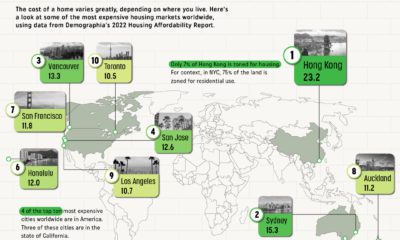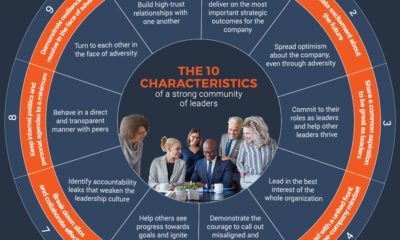Before the COVID-19 outbreak, over half of all professionals globally worked remotely at least 2.5 days a week. This has since increased dramatically, with 88% of organizations now insisting their employees work from home and implement social distancing. Leaders must adapt to a more flexible workplace and create a culture of accountability so that their organization can successfully weather the COVID-19 storm.
Leadership Accountability in Uncertain Times
Today’s infographic, from bestselling author Vince Molinaro, reveals the five behaviors that leaders can adopt in order to provide thoughtful navigation through uncertainty.
Join Vince Molinaro’s Community of Accountable Leaders
The Impact of Leadership Accountability
As the workforce pivots to remote working arrangements, the benefits of flexible working policies are coming into sharper focus. Research shows that these policies can lower overhead costs, reduce commuting times and increase employee satisfaction—in addition to attracting top talent. Moreover, the shift to working remotely could boost the U.S. economy by $4.5 trillion annually by 2030. But achieving these benefits requires accountability from everyone in an organization, and in an increasingly virtual world, that can become difficult to manage.
Challenges Facing Leaders Today
Leaders are already subject to an array of challenges that they must overcome, such as:
The pressure to differentiate: Leaders feel an unrelenting pressure to innovate and help their organizations stand out in a sea of ruthless competitors. Executing the strategy: Leaders must align the organization to ensure employees are clear about what needs to get done to execute priorities seamlessly. Leading transformational change: With so many moving parts, constant change across several aspects of a business can be difficult for leaders to manage. Creating enduring value: Customers, boards, and shareholders have high expectations for leaders in exchange for their loyalty. Building future talent: Leaders must build and nurture the next generation of leaders in addition to managing the day-to-day.
These mounting pressures can have a detrimental impact on a business leader’s performance, so it is crucial that they get the support they need now, more than ever.
The Characteristics of Accountable Leaders
Truly accountable leadership is the only way an organization can weather uncertainty in a world that has been upended. Research reveals that among the strongest performing companies, accountable leaders consistently demonstrate five behaviors that set them apart from others.
Leading The Future
As we embrace the unknown, it is clear that leadership accountability will become more important than ever. In fact, it has become a crucial element for future-proofing organizations in times of crisis or drastic change. Perhaps more importantly, it is necessary for encouraging teams to emerge more connected and resilient than ever before. on Last year, stock and bond returns tumbled after the Federal Reserve hiked interest rates at the fastest speed in 40 years. It was the first time in decades that both asset classes posted negative annual investment returns in tandem. Over four decades, this has happened 2.4% of the time across any 12-month rolling period. To look at how various stock and bond asset allocations have performed over history—and their broader correlations—the above graphic charts their best, worst, and average returns, using data from Vanguard.
How Has Asset Allocation Impacted Returns?
Based on data between 1926 and 2019, the table below looks at the spectrum of market returns of different asset allocations:
We can see that a portfolio made entirely of stocks returned 10.3% on average, the highest across all asset allocations. Of course, this came with wider return variance, hitting an annual low of -43% and a high of 54%.
A traditional 60/40 portfolio—which has lost its luster in recent years as low interest rates have led to lower bond returns—saw an average historical return of 8.8%. As interest rates have climbed in recent years, this may widen its appeal once again as bond returns may rise.
Meanwhile, a 100% bond portfolio averaged 5.3% in annual returns over the period. Bonds typically serve as a hedge against portfolio losses thanks to their typically negative historical correlation to stocks.
A Closer Look at Historical Correlations
To understand how 2022 was an outlier in terms of asset correlations we can look at the graphic below:
The last time stocks and bonds moved together in a negative direction was in 1969. At the time, inflation was accelerating and the Fed was hiking interest rates to cool rising costs. In fact, historically, when inflation surges, stocks and bonds have often moved in similar directions. Underscoring this divergence is real interest rate volatility. When real interest rates are a driving force in the market, as we have seen in the last year, it hurts both stock and bond returns. This is because higher interest rates can reduce the future cash flows of these investments. Adding another layer is the level of risk appetite among investors. When the economic outlook is uncertain and interest rate volatility is high, investors are more likely to take risk off their portfolios and demand higher returns for taking on higher risk. This can push down equity and bond prices. On the other hand, if the economic outlook is positive, investors may be willing to take on more risk, in turn potentially boosting equity prices.
Current Investment Returns in Context
Today, financial markets are seeing sharp swings as the ripple effects of higher interest rates are sinking in. For investors, historical data provides insight on long-term asset allocation trends. Over the last century, cycles of high interest rates have come and gone. Both equity and bond investment returns have been resilient for investors who stay the course.














